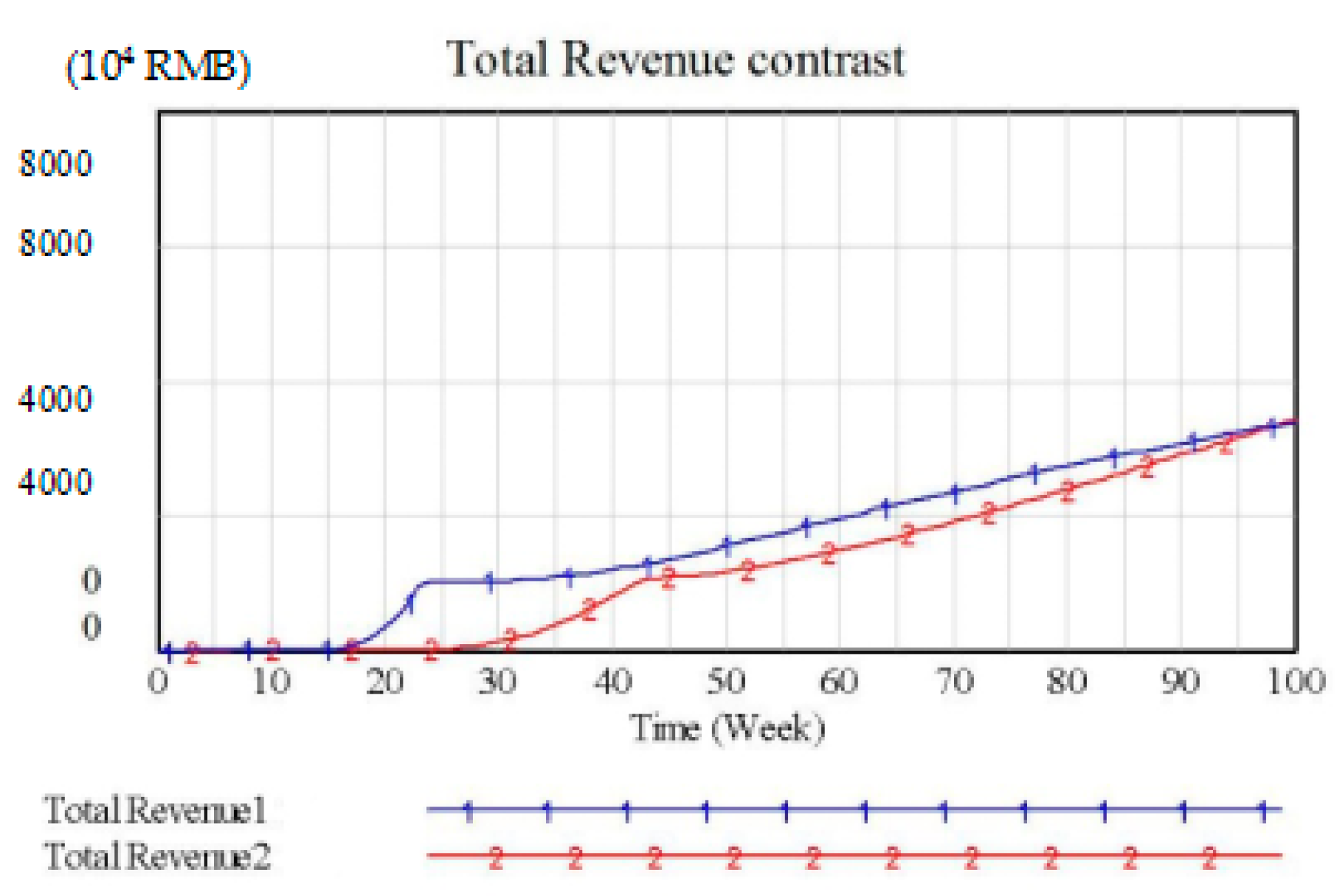Dual Chains Competition under Two Recycling Modes Based on System Dynamics Method
Abstract
1. Introduction
2. Literature Review
3. Materials and Methods
3.1. Systems Dynamics
3.2. The Case Studies
3.3. Competition Model
≤ (0.7 × E-waste), IF THEN ELSE (Retailers Recycling Inventory
≤ (0.4 × E-waste), IF THEN ELSE (Retailers Recycling Inventory
≤ (0.1 × E-waste), 0.05, 0.25), 0.4), 0.55).
3.4. Causal Loop Diagram of Inter-Chain Competition and Inner-Chain Competition
4. Simulation and Discussion
≤ (0.7 * E-waste), IF THEN ELSE (Retailers Recycling Inventory
≤ (0.4 * E-waste), IF THEN ELSE (Retailers Recycling Inventory
≤ (0.1 * E-waste), 0.15, 0.35), 0.45), 0.65).
Proportion + Quality Factor 1 * (1 − Service Factor Proportion)))/(Service Factor 1 *
Service Factor Proportion + Quality Factor 1 * (1 − Service Factor Proportion) + Service
Factor 2 * Service Factor Proportion + Quality Factor 2 * (1 − Service Factor Proportion))
Proportion + Quality Factor 2 * (1 − Service Factor Proportion)))/(Service Factor 1 *
Service Factor Proportion + Quality Factor 1 * (1 − Service Factor Proportion) + Service
Factor 2 * Service Factor Proportion + Quality Factor 2 * (1 − Service Factor Proportion))
5. Conclusions
Author Contributions
Funding
Conflicts of Interest
References
- Ahsan, K.; Rahman, S. An investigation into critical service determinants of customer to business (C2B) type product returns in retail firms. Int. J. Phys. Distrib. Logist. Manag. 2016, 46, 606–633. [Google Scholar] [CrossRef]
- Marketwatch. Consumers Return $642.6 Billion in Goods each Year. Available online: http://www.marketwatch.com/story/consumers-return-6426-billion-in-goods-each-year-201506-18 (accessed on 22 September 2017).
- The Guardian. China’s Booming Middle Class drives Asia’s Toxic e-Waste Mountains. Available online: https://www.theguardian.com/environment/2017/jan/16/chinas-booming-middle-class-drivesasias-toxic-e-waste-mountains 16/01/17 (accessed on 24 September 2017).
- Pantano, E.; Iazzolino, G.; Migliano, G. Obsolescence risk in advanced technologies for retailing: A management perspective. J. Retail. Consum. Serv. 2013, 20, 225–233. [Google Scholar] [CrossRef]
- Lu, B.; Liu, J.; Yang, J.; Li, B. The environmental impact of technology innovation on WEEE management by multi-Life cycle assessment. J. Clean. Prod. 2015, 89, 148–158. [Google Scholar] [CrossRef]
- Gunningham, N.; Sinclair, D. Leaders and laggards: Next-Generation Environmental Regulation. Routledge. Gree Website, Gree Electric Appliances Inc. of Zhuhai China, Company Profile. Available online: http://global.gree.com/ywb/aboutgree/companyintroduction/index.shtml (accessed on 23 September 2017).
- Ramanathan, R.; He, Q.; Black, A.; Ghobadian, A.; Gallear, D. Environmental regulations, innovation and firm performance: A revisit of the Porter hypothesis. J. Clean. Prod. 2017, 155, 79–92. [Google Scholar] [CrossRef]
- Shaharudin, M.R.; Govindan, K.; Zailani, S.; Tan, K.C.; Iranmanesh, M. Product return management: Linking product returns, closed-loop supply chain activities and the effectiveness of the reverse supply chains. J. Clean. Prod. 2017, 149, 1144–1156. [Google Scholar] [CrossRef]
- He, Y. Supply risk sharing in a closed-loop supply chain. Int. J. Prod. Econ. 2017, 183, 39–52. [Google Scholar] [CrossRef]
- Suki, N.M.; Suki, N.M. Correlations between awareness of green marketing, corporate social responsibility, product image, corporate reputation, and consumer purchase intention. In Green Marketing and Environmental Responsibility in Modern Corporations; IGI Global: Hershey, PA, USA, 2017; pp. 201–215. [Google Scholar]
- Sadovnikova, A.; Pujari, A. The effect of green partnerships on firm value. J. Acad. Mark. Sci. 2017, 45, 251–267. [Google Scholar] [CrossRef]
- Govindan, K.; Soleimani, H. A review of reverse logistics and closed-loop supply chains: A Journal of Cleaner Production focus. J. Clean. Prod. 2017, 142, 371–384. [Google Scholar] [CrossRef]
- Abbey, J.D.; Guide, V.D.R., Jr. Closed-Loop Supply Chains: A Strategic Overview; Springer: Berlin/Heidelberg, Germany, 2017; pp. 375–393. [Google Scholar]
- Zhang, J.; Li, H.; Yan, R.; Johnston, C. Examining the signaling effect of retailers’ return policies. J. Comput. Inf. Syst. 2017, 57, 191–200. [Google Scholar]
- Murfield, M.; Murfield, M.; Boone, A.; Rutner, P.; Thomas, R. Investigating logistics service quality in omni-channel retailing. Int. J. Phys. Distrib. Logist. Manag. 2017, 47, 263–296. [Google Scholar] [CrossRef]
- Savaskan, R.C.; Bhattacharya, S.; Van Eisenhower, L.N. Channel Choice and Coordination in a Remanufacturing Environment; INSEAD: Fontainebleau, France, 2000. [Google Scholar]
- Savaskan, R.C.; Wassenhove, L.N.V. Reverse channel design: The case of competing retailers. Manag. Sci. 2006, 52, 1–14. [Google Scholar] [CrossRef]
- Tansel, B. From electronic consumer products to e-wastes: Global outlook, waste quantities, recycling challenges. Environ. Int. 2017, 98, 35–45. [Google Scholar] [CrossRef] [PubMed]
- Xu, B.; Yang, J.M. Research on competition between two closed-loop supply chains and coordination within one closed-loop supply chain under stochastic demand. J. Nanchang Univ. (Eng. Technol.) 2012, 34, 300–306. [Google Scholar]
- Sun, J.Y.; Teng, C.X.; Chen, Z.B. Dynamic model of closed-loop supply chain network with product remanufacturing based on differential variational inequality. Syst. Eng. Theory Pract. 2015, 35, 1155–1164. [Google Scholar]
- Choi, T.M.; Li, Y.; Xu, L. Channel leadership, performance and coordination in closed loop supply chains. Int. J. Prod. Econ. 2013, 146, 371–380. [Google Scholar] [CrossRef]
- Masi, D.; Day, S.; Godsell, J. Supply chain configurations in the circular economy: A systematic literature review. Sustainability 2017, 9, 1602. [Google Scholar] [CrossRef]
- Hong, X.P.; Xu, L.; Du, P. Joint advertising, pricing and collection decisions in a closed-loop supply chain. Int. J. Prod. Econ. 2015, 167, 12–22. [Google Scholar] [CrossRef]
- Song, M.; Huang, M.; Wang, X.W. Selection strategies of channel structure for competing closed-loop supply chains. Control Decis. 2013, 28, 1247–1252. [Google Scholar]
- Tanskanen, P. Management and recycling of electronic waste. Acta Mater. 2013, 61, 1001–1011. [Google Scholar] [CrossRef]
- Varsei, M.; Soosay, C.; Fahimnia, B.; Sarkis, J. Framing sustainability performance of supply chains with multidimensional indicators. Supply Chain Manag. Int. J. 2014, 19, 242–257. [Google Scholar] [CrossRef]
- Ahi, P.; Searcy, C. An analysis of metrics used to measure performance in green and sustainable supply chains. J. Clean. Prod. 2015, 86, 360–377. [Google Scholar] [CrossRef]
- Golroudbary, S.R.; Zahraee, S.M. System dynamics model for optimizing the recycling and collection of waste material in a closed-loop supply chain. Simul. Model. Pract. Theory 2015, 53, 88–102. [Google Scholar] [CrossRef]
- Hu, H.C.; Hu, X.Y.; Meng, Z.W.; Zhai, W.T. Research on Recycling Strategy of Retailer cooperating with the Third-party in Closed-loop Supply Chain. In Proceedings of the International Conference on Education Technology, Management and Humanities Science, Xi’an, China, 21–22 March 2015; pp. 941–945. [Google Scholar]
- Zhang, X.Q.; Yuan, X.G. The System Dynamics Model in Electronic Products Closed-Loop Supply Chain Distribution Network with Three-Way Recovery and the Old-for-New Policy. Discrete Dyn. Nat. Soc. 2016, 3, 1–10. [Google Scholar] [CrossRef]
- Zhang, K. Research on Pricing Decision of Closed-Loop Supply Chain Based on Carbon Tax. Int. J. Econ. Financ. Manag. Sci. 2015, 3, 623–629. [Google Scholar]
- Sasikumar, P.; Haq, A.N. Integration of closed loop distribution supply chain network and 3PRLP selection for the case of battery recycling. Int. J. Prod. Res. 2011, 49, 3363–3385. [Google Scholar] [CrossRef]
- Georgiadis, P. An integrated System Dynamics model for strategic capacity planning in closed-loop recycling networks: A dynamic analysis for the paper industry. Simul. Model. Pract. Theory 2013, 32, 116–137. [Google Scholar] [CrossRef]
- Hong, I.H.; Yeh, J.S. Modeling closed-loop supply chains in the electronics industry: A retailer collection application. Transp. Res. Part E 2012, 48, 817–829. [Google Scholar] [CrossRef]
- Huang, M.; Song, M.; Loo, H.L. Analysis for strategy of closed-loop supply chain with dual recycling channel. Int. J. Prod. Econ. 2013, 144, 510–520. [Google Scholar] [CrossRef]
- Wei, J.; Govindan, K.; Li, Y.J. Pricing and collecting decisions in a closed-loop supply chain with symmetric and asymmetric information. Comput. Oper. Res. 2015, 54, 257–265. [Google Scholar] [CrossRef]
- Cao, J.; Xu, J.; Wang, H.; Zhang, X.; Chen, X.; Zhao, Y.; Yang, X.; Zhou, G.; Schnoor, J.L. Innovating Collection Modes for Waste Electrical and Electronic Equipment in China. Sustainability 2018, 10, 1446. [Google Scholar] [CrossRef]
- Yi, Y.Y. Study on closed-loop supply chain models under different marker power. J. Syst. Manag. 2010, 19, 389–396. [Google Scholar]
- Wang, X.; Gao, P.; Jing, Y. Closed-loop supply chain disruptions management with two retailers’ competition. Comput. Integr. Manuf. Syst. 2014, 20, 430–439. [Google Scholar]
- Huang, Z.S.; Nie, J.J.; Hu, P. Differential game model in closed-loop supply chain with competing retailers. J. Syst. Eng. 2015, 30, 779–789. [Google Scholar]
- Han, X.H.; Xue, S.J. Reverse channel decision for competition closed-loop supply chain based on evolutionary game. Comput. Integr. Manuf. Syst. 2010, 16, 1487–1493. [Google Scholar]
- Wu, H.Y.; Han, X.H. Production decision in manufacturer competing closed-loop supply chains under remanufacturing costs disruptions scenarios. Comput. Integr. Manuf. Syst. 2016, 2016 22, 1129–1138. [Google Scholar]
- Wang, W.B.; Chen, Q.; Da, Q.L. Decision and analysis of closed-loop supply chain with manufacturer-led and manufacturer-compete based on the reward-penalty mechanism. Chin. J. Manag. Sci. 2013, 21, 57–63. [Google Scholar]
- Wang, W.B.; Deng, W.W.; Bai, T. Design the Reward-penalty Mechanism for Reverse Supply Chains Based on Manufacturers’ Competition and Carbon Footprint Constraints. J. Ind. Eng. Eng. Manag. 2016, 30, 188–194. [Google Scholar] [CrossRef]
- Liu, Y.; Zhang, Y. Closed Loop Supply Chain under Power Configurations and Dual Competitions. Sustainability 2018, 10, 1617. [Google Scholar] [CrossRef]
- Forrester, J.W. Industrial dynamics. J. Oper. Res. Soc. 1997, 48, 1037–1041. [Google Scholar] [CrossRef]
- Forrester, J.W. System dynamics-the next fifty years. Syst. Dyn. Rev. 2007, 23, 359–370. [Google Scholar] [CrossRef]
- Haier Group. Haier 2011 Environmental Report. Available online: http: //www.haier.net/cn/social responsibility/environmental protection/book (accessed on 5 June 2012).
- Zou, X.L.; Zhao, M.Y. Renewable resources: Gree electric appliance “losing business”. China Econ. Wkly 2014, 17, 66–68. [Google Scholar]
- The Report of China’s Home Appliance Industry Market Development Status and investment Prospects Forecast from 2017 to 2022. Available online: http://www.chinabgao.com/report/3507227.html (accessed on 16 December 2017).










| Variable Meaning | Variable Name |
|---|---|
| Collection Points Coverage Rate | Cr |
| Discarded Rate | Dr |
| Environmental Protection Consciousness of Consumers | Ce |
| E-waste | E |
| E-waste Recycling Coefficient | Ec |
| E-waste Recycling Rate | Er |
| Processed Inventory | Ip |
| Processing Rate | Pr |
| Reused Rate | Rr |
| The Third-Party Recycling Inventory | It |
© 2018 by the authors. Licensee MDPI, Basel, Switzerland. This article is an open access article distributed under the terms and conditions of the Creative Commons Attribution (CC BY) license (http://creativecommons.org/licenses/by/4.0/).
Share and Cite
Xue, R.; Zhang, F.; Tian, F.; Oloruntoba, R.; Miao, S. Dual Chains Competition under Two Recycling Modes Based on System Dynamics Method. Sustainability 2018, 10, 2382. https://doi.org/10.3390/su10072382
Xue R, Zhang F, Tian F, Oloruntoba R, Miao S. Dual Chains Competition under Two Recycling Modes Based on System Dynamics Method. Sustainability. 2018; 10(7):2382. https://doi.org/10.3390/su10072382
Chicago/Turabian StyleXue, Renzheng, Fengbin Zhang, Feng Tian, Richard Oloruntoba, and Shidi Miao. 2018. "Dual Chains Competition under Two Recycling Modes Based on System Dynamics Method" Sustainability 10, no. 7: 2382. https://doi.org/10.3390/su10072382
APA StyleXue, R., Zhang, F., Tian, F., Oloruntoba, R., & Miao, S. (2018). Dual Chains Competition under Two Recycling Modes Based on System Dynamics Method. Sustainability, 10(7), 2382. https://doi.org/10.3390/su10072382




